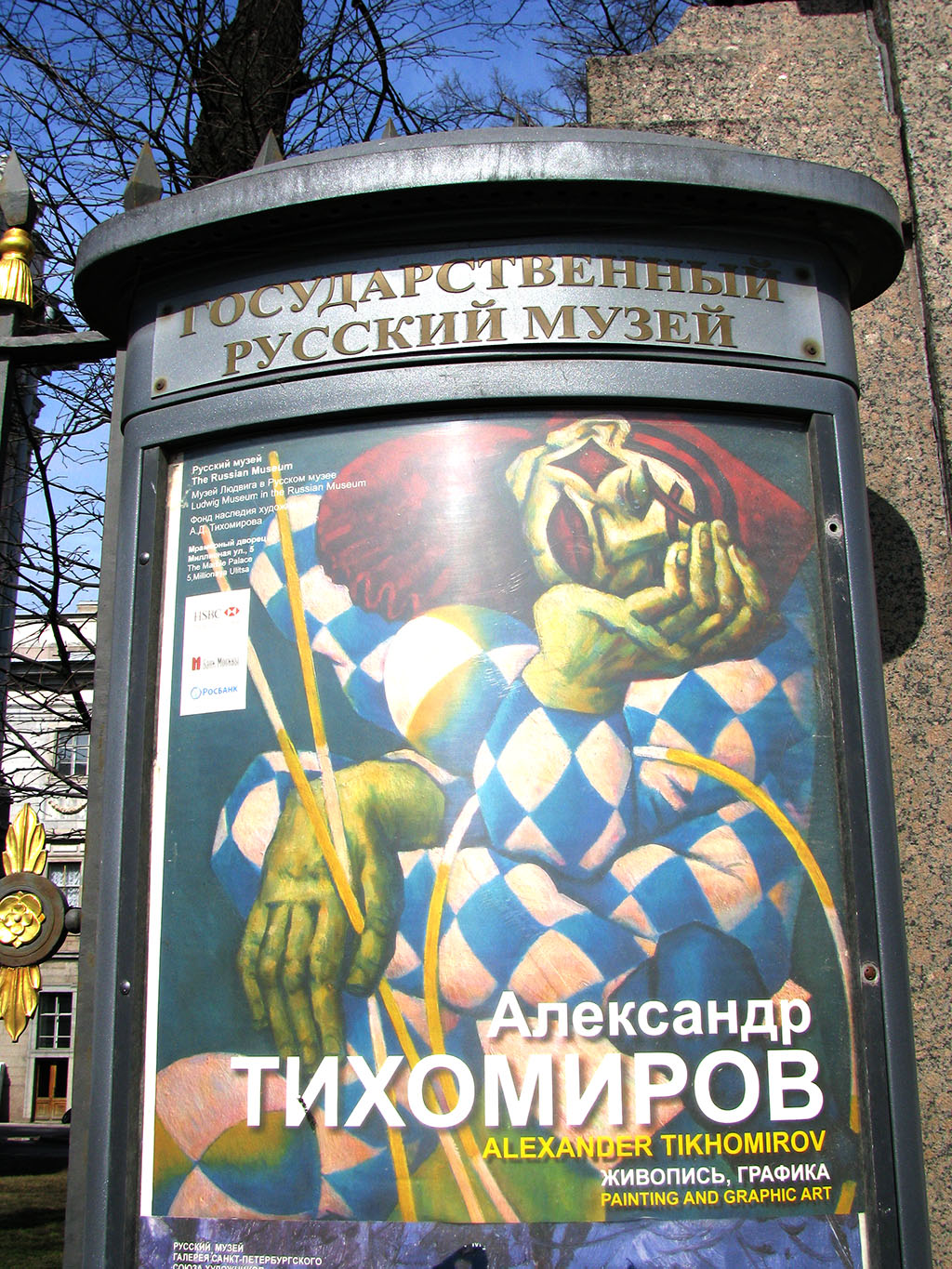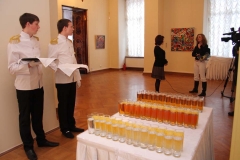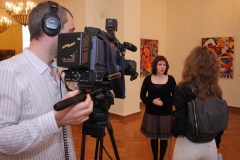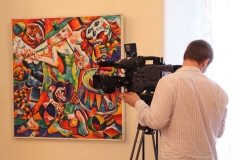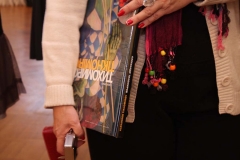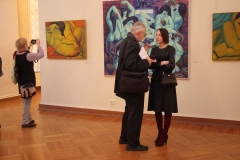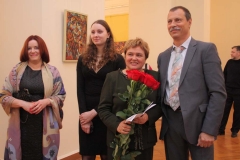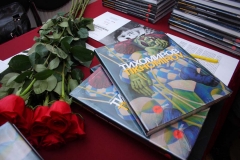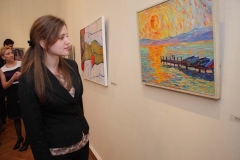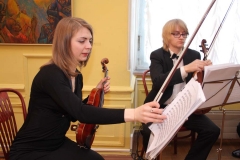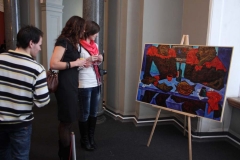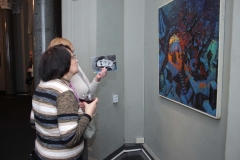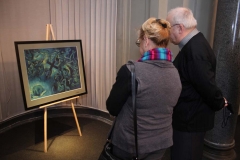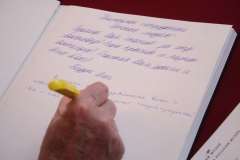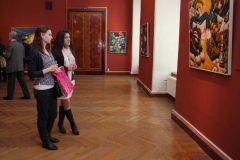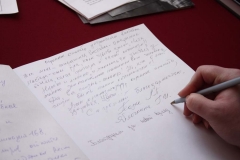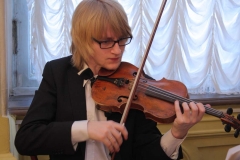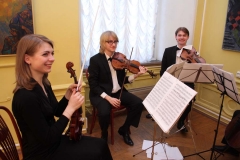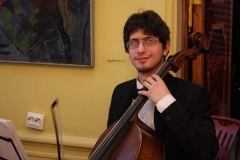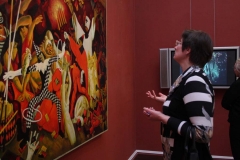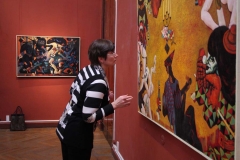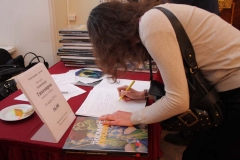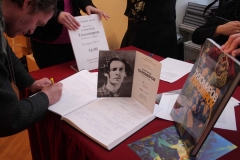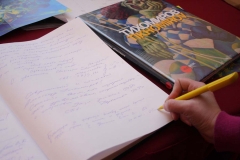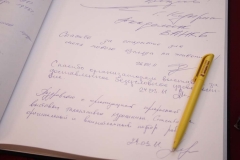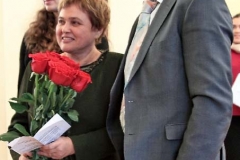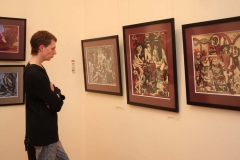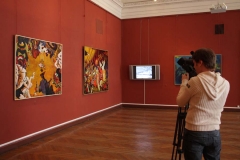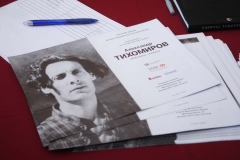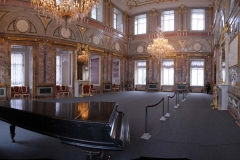Russian Museum (Saint-Petersburg)
Ludwig’s Museum of the Russian Museum
Heritage Foundation of the artist A.D. Tikhomirov
March, 25 – May, 16, 2011.
In March, 24th, official ceremony of opening of retrospective exhibition “Alexander Tikhomirov. Art. Graphics” took place in the halls of Marble Palace of the State Russian Museum (Saint-Petersburg), devoted to the 95th anniversary from the date of birth of the master.
Exposition includes around 50 pictorial and graphic works, to the full extent representing A.D. Tikhomirov’s art heritage – from early realistic and impressionistic works and up to late works of neoclassic period, including those never exhibited before.
For the first time Saint-Petersburg public gained opportunity to become acquainted not only with works of the Moscow artist, but to learn about his life and creative biography.
Opening of the exhibition coincided with release of the catalogue “Alexander Tikhomirov” containing over 180 works of the artist.
Opening of the exhibition has been broadcasted by the first channel of Saint-Petersburg television, “Radio Peterburg” radio station and Saint-Petersburg and Moscow newspapers.
Documentary movie about life and art of A.D. Tikhomirov “With eyes turned deep into the soul…” directed by Y.S. Nazarov is broadcasted in the last hall of the exposition.
AT THE OPENING
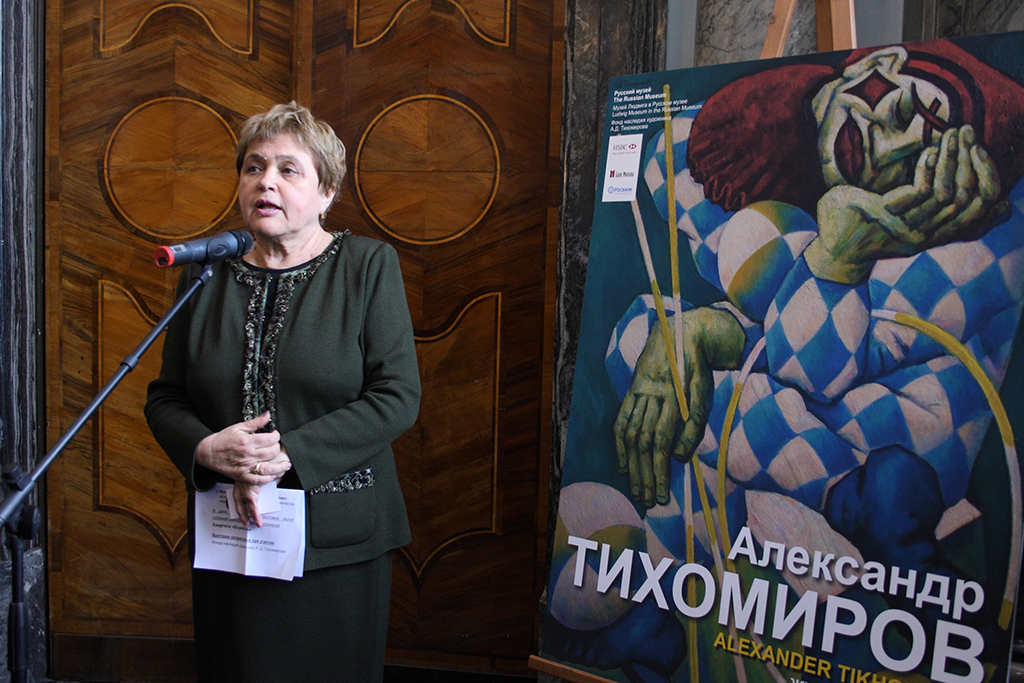
Quote from the speech by Deputy Director of the Russian Museum in charge of scientific work Petrova Evgeniya Nikolaevna:
“We are glad to see you at the opening of this exhibition today, and, before we open these doors, I’d like to say that we believed that the art of the second half of XX century is well known to us.
Many of those present here witnessed those times and have an idea about the art of that period. We remember famous painters of that time – recognized officially and those, nowadays referred to as an underground. We know them personally; saw their works at various exhibitions. Now we are already reading articles and books about both of them, today when all discussions about left and right directions have almost subsided, some stories from that era are still written. All the names are known by now – art works, styles, manners – all is known and we have a vision about the second half of XX century.
And suddenly we discover the artists who, as it happens, have been working for themselves in a completely different way than they did performing official orders or when living some kind of official life. At the same time they cannot be referred to the underground artists: they did not fight, did not speak up, their works have not been destroyed by bulldozers – none of it has happened.
And the artist in question, whose exhibition we are opening today, was from amongst those artists, and he is not the only one. There have been other masters who can be referred neither to official artists, nor to the underground. This is something completely different, and this “completely different” still did not find its place in the history or art, and there is so far no definition to this “different”. And, as usual, it takes a while before such definition could be found. It is found after the exhibitions, when the works are displayed, and only then comes comprehension of the place which should be given to such artists in art. But to make this happen, come into reality, we need people who would promote higher awareness of their works and recognition of their art. And in this particular case I’d like to say that this artist is lucky: there is a Foundation of heritage of the artist, undertaking active efforts to promote this master, and all these events come into being thanks to this Foundation. Exhibition in our museum was organized by the second half of XX century art department and we hope that there will be exhibitions in other places, maybe, with different set up and in another composition”.
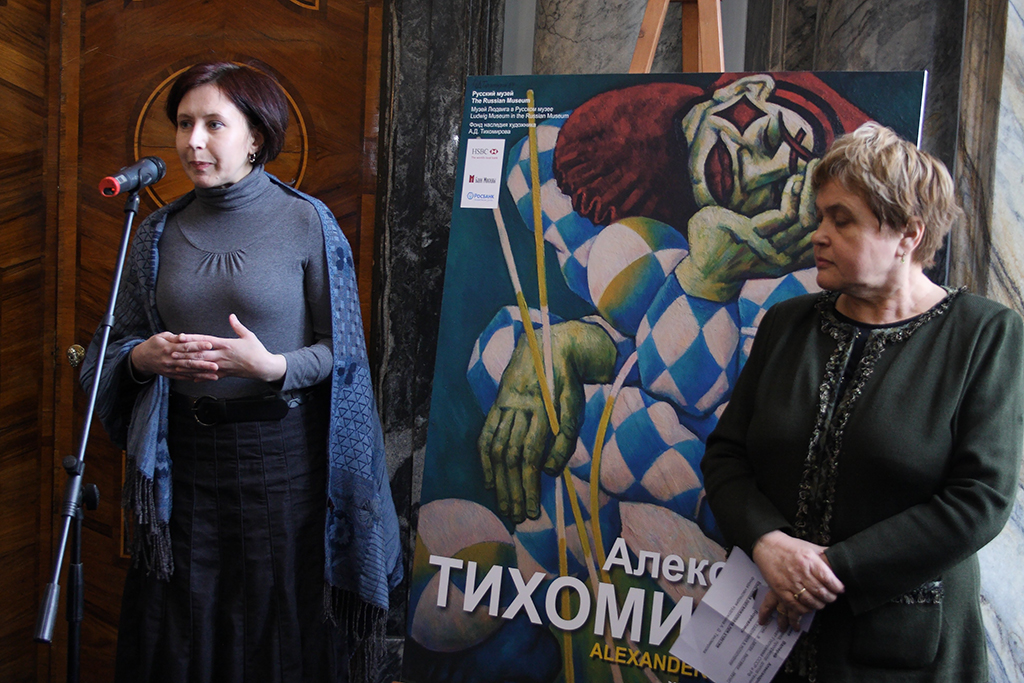
Quote from the speech by the exhibition supervisor Shakirova Lyubov Viktorovna (Russian Museum):
“What is the value of exhibition for the Russian Museum? It turned out to become such an unexpected, puzzling and a very elegant comment to “Time of change” line started by us some years ago. As it came out, there have been left artists, right artists and then there was also such an unpredictable Tikhomirov, who has been extremely limited by his professional activities, as he had to verify each of his movement with the general line. He was a monumental style artist working on very important governmental orders.
As it turned out, he had his hiding places in his soul and his art, and now we have an opportunity to reveal them to everyone. This is a very perceptive exhibition: it tells us about the freedom of art, that under any pressing a true artist will always find space for freedom. And such space for Tikhomirov was in his workshop, where he created his works in absolute freedom. He didn’t put any efforts to promotion of his art, didn’t strive to be exhibited. In general, I believe that this is the right behavior. At the end of the day, now, after death of the artist, there is now a support group, whose efforts allowed us reconstructing his work in full and revealing his world. The main motive which strikes an eye and goes as a golden thread through entire exhibition is the man in a mask.
I’d like to wish all of us to treat those works with full sincerity. Thanks to everyone who worked on this exhibition and who made it happen”.
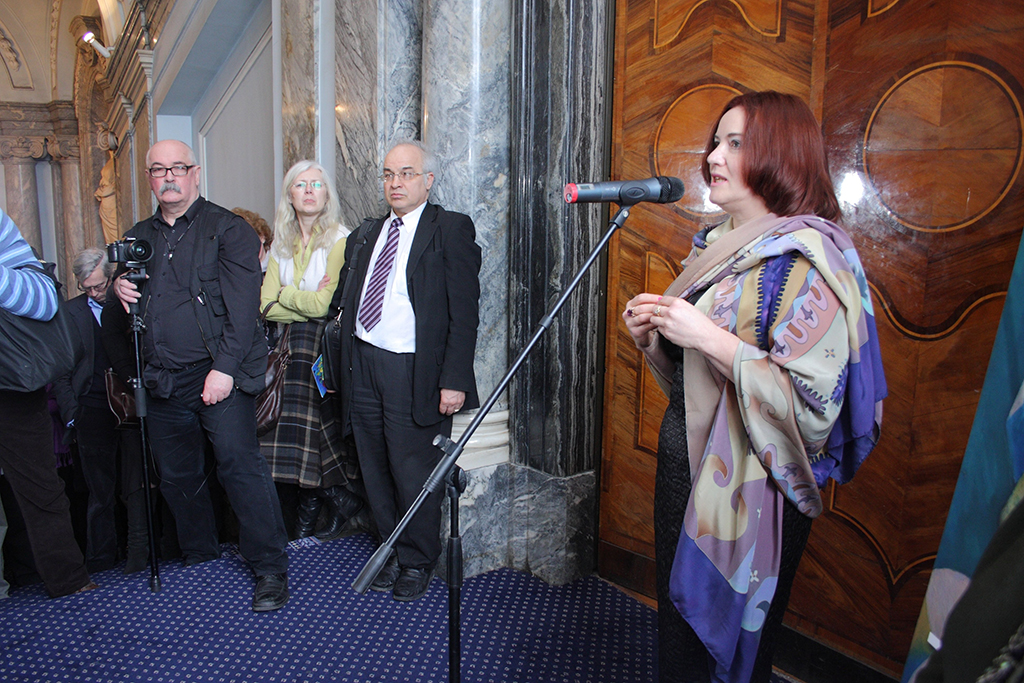
Quote from the speech by the exhibition supervisor Uritskaya Irina Feliksovna (Moscow):
“First of all I’d like to thank Russian Museum for such a warm welcome of our exhibition, for such a careful work with materials, for a wonderful catalogue, I know that Evgeniya Nikolaevna has worked a lot on it personally and lent lots of her soul into this task, devoting her professionalism and desire to convey the art of this painter in the most colorful and exhaustive way. Great thanks to everyone who contributed to running of this exhibition in Saint-Petersburg.
And I think that thanks to Evgeniya Nikolaevna’s good graces we shall succeed in organizing this exhibition in other places, showing people art of the painter and telling them about his life”.
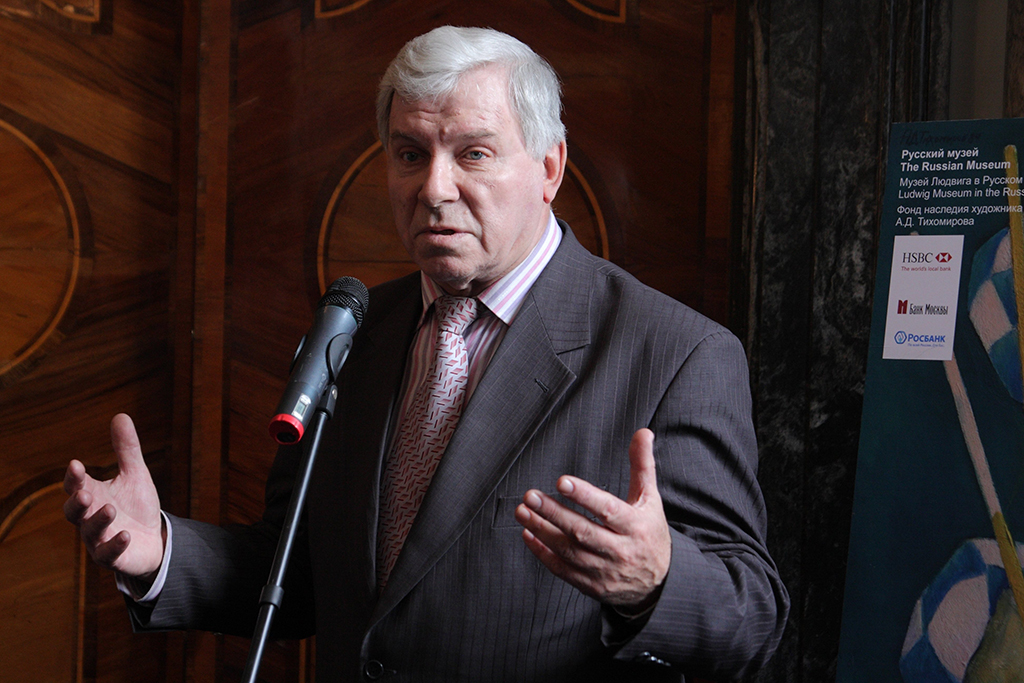
Quote from the speech by the friend of the artist, art expert, completist, professor of Moscow State Technical University named after N.E. Bauman Matveev Valery Alexandrovich:
“Dear ladies and gentlemen! I’m very happy with opening of this exhibition. Some time ago the Russian Museum re-discovered Filonov, and now we are re-introducing Alexander Dmitrievich Tikhomirov to public. And on behalf of professorship of Bauman’s Moscow State Technical University, who have always loved and supported the artist Tikhomirov, I’d like to express gratitude to the Russian Museum for organizing this exhibition.
Alexander Dmitrievich dreamt of connecting the classics with modernity, and he suceeded in doing so. Let’s wish the artist Tikhomirov to keep developing in time and space day by day. I think that it shall be appreciated. He has always told me: “You’ll see – my works will be demanded”.
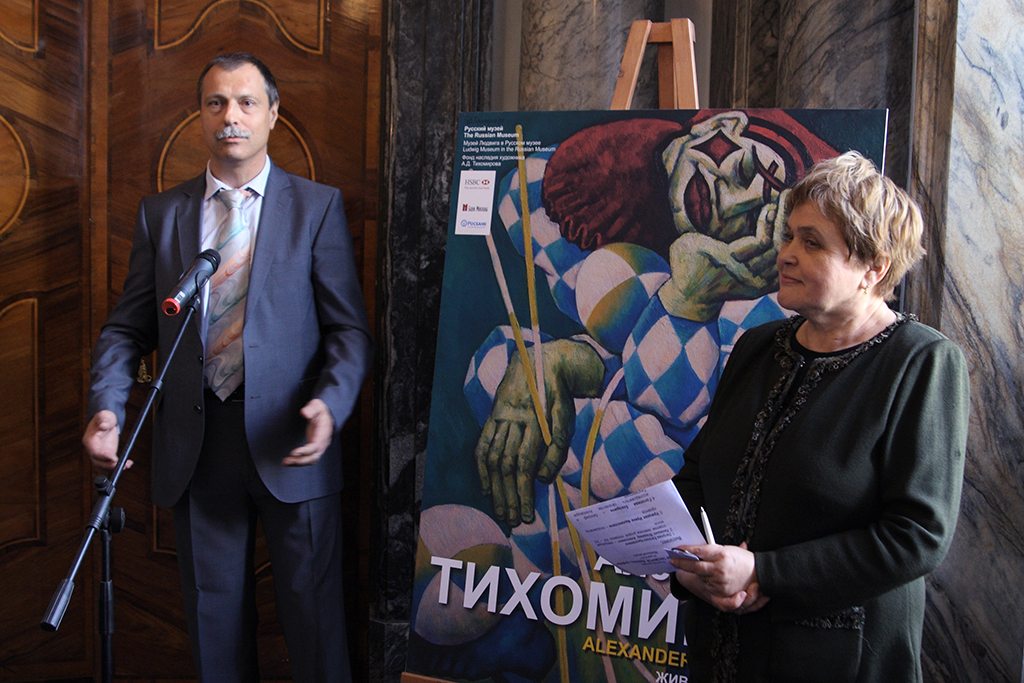
Quote from the speech by the Chairperson of Supervisory Council of the artist A.D. Tikhomirov’s Heritage Foundation Zhigarev Gennady Anatolyevich:
“Dear ladies and gentlemen, I won’t take much of your attention, I’ll only tell you a family story. Since long I heard from my mother-in-law about Shurik – Shurik said this and Shurik said that. But then our family got a painting which was hanging above my little daughter’s bed. I didn’t pay much attention to it, but my daughter was fond of it. More than 10 years have passed till the day when I really got introduced to the art of Alexander Dmitrievich Tikhomirov, who turned out to be that very Shurik so frequently mentioned by my mother-in-law. And now Heritage Foundation of the artists Tikhomirov has been established. We’d like to present you what we have managed to achieve. Big gratitude to the Russian Museum for great support provided to us”.
Press-conference was held for mass-media prior to opening of the exhibition.
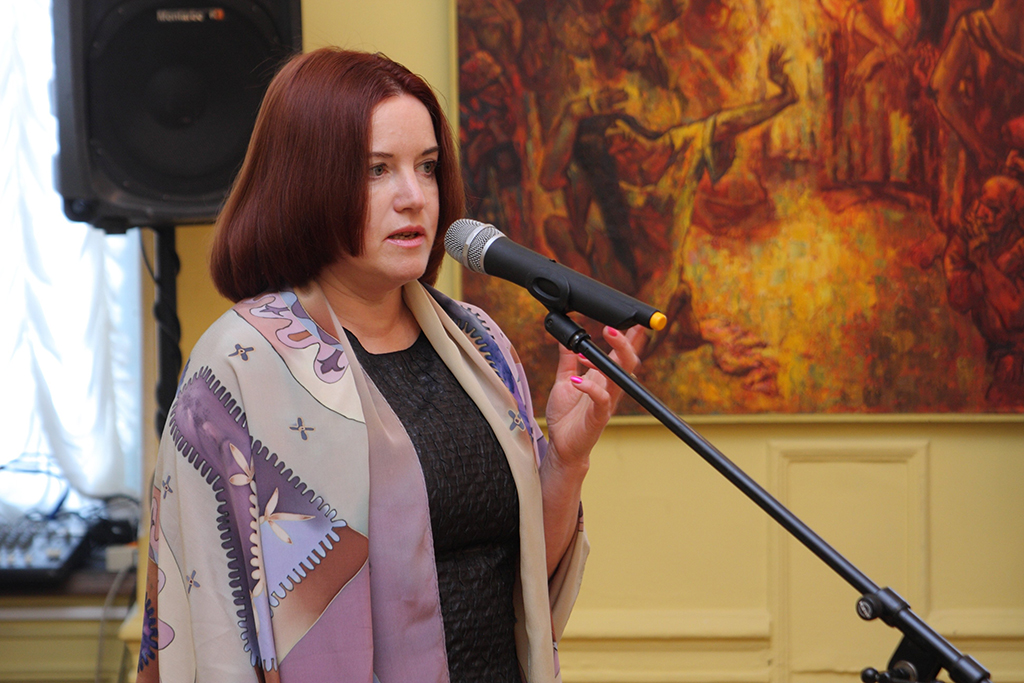
Quote from the speech by the exhibition supervisor Uritskaya Irina Feliksovna:
“Good day, dear friends!
I’m happy for an opportunity to return to these wonderful halls and take part in the opening of this wonderful exhibition.
The artist, which we are presenting today, and which, I hope, shall attract attention of Saint-Petersburg public, as he attracted much attention of the public in Moscow, is interesting first of all by the fact that his art for us, art experts and people working in the field of art, – is an unknown page in the history of the Russian art of the XX century.
It seems to us that we know everything about art. We are studying the art of Russian painters of that period, who lived in Russia, South America, France and Germany. And all of a sudden there comes a person who has been drawing his paintings “into the desk”, which was a common practice for many in 50-80s. And it turns out that this painter created a powerful heritage, that he worked “into the desk”, but not in isolation from contemporary European movements, but in context of those movements and in context of art history of the XX century. And this we cannot deny. Moreover, for many years he has been friends with the artists of the same period, well known to us. He was friends with Fahlk, he was friends with Peredny; he was friends with Adlivankin and Labas. There is an absolutely stunning portrait of Tikhomirov by Peredny. They presented their works to each other, discussed their art with each other. But while other painters of this circle were willing to socialize, take part in various open or half-closed exhibitions, Alexander Dmitrievich was not socializing, did not get involved into that process.
Indeed, this is a big mystery to us: why? One would think why, being acquainted with entire artistic society and rotating in artistic circles, did he not take part in their social life? Because he needed to feed his family, he needed to work. He worked from eight o’clock in the morning to eight o’clock in the evening on a daily basis, and he simply did not have time to promote himself in any way. Apparently, he didn’t have a gift of such self-promotion, self-advancement, or self-PR, as we would say nowadays. And his paintings were known to fairly small in gathering of amateur completists, who were buying his works, discussed new art trends with him, together with whom he was listening to the music. At that these people were fairly alien to art; they have been scientists, mathematicians, physicists. However, as a matter of fact, that could be to the best, as his heritage remained untouched, unsold and not dispersed throughout various collections, small museums and galleries. And that’s why now we have an opportunity to make a judgment about his art as it is now – from the earliest and up to his latest works”.
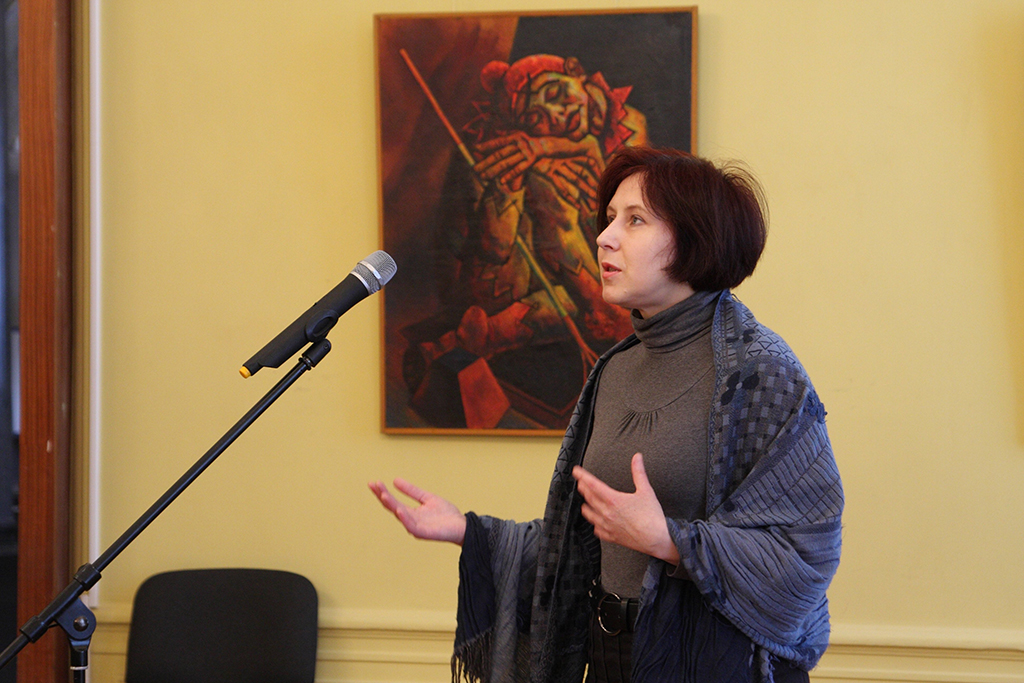
Quote from the speech of the exhibition supervisor Shakirova Lyubov Viktorovna (Russian Museum):
“I’d like to add a few words about comprehension of uniqueness of this exhibition, as this is an absolutely special artist, the one we never had in our museum before. He cannot be called unknown. He is a very famous unknown artist, as he was famous, he was a monumental art painter and performed works of highest importance, forming the main frontage of Moscow. It was strictly regulated and very professional work, and most of people who have known Tikhomirov in this capacity were not acquainted with Tikhomirov, whom we see at this exhibition. And now we are discovering him.
And it’s very good that there are people – both the artist’s family members and powerful support group who make all possible efforts to recover historical justice and to merge these two Tikhomirovs into one personality – an absolutely amazing and unique one. This is a very edificatory exhibition for us, as we casually perceive the art of 60-80s through opposition – official and unofficial artists. However, example of such people as Tikhomirov once more proves this scheme to be some kind of temporary solution which will eventually and inevitable diffuse. It will diffuse because it is not acceptable to make unambiguous judgments, as not all the artists, not all people who created their works freely, were put under the bulldozer. For Tikhomirov to remain a free artist, it was enough to close the door of his workshop or his room behind him. And in these issues he expressed himself absolutely freely. Here all of his esthetic preferences, all his thoughts about the art, and entire flow of images – all of it did not have any censorship. This is very interesting. I’d very much like to join him, be happy and sympathize the artist, for what he has been deprived of in life”.
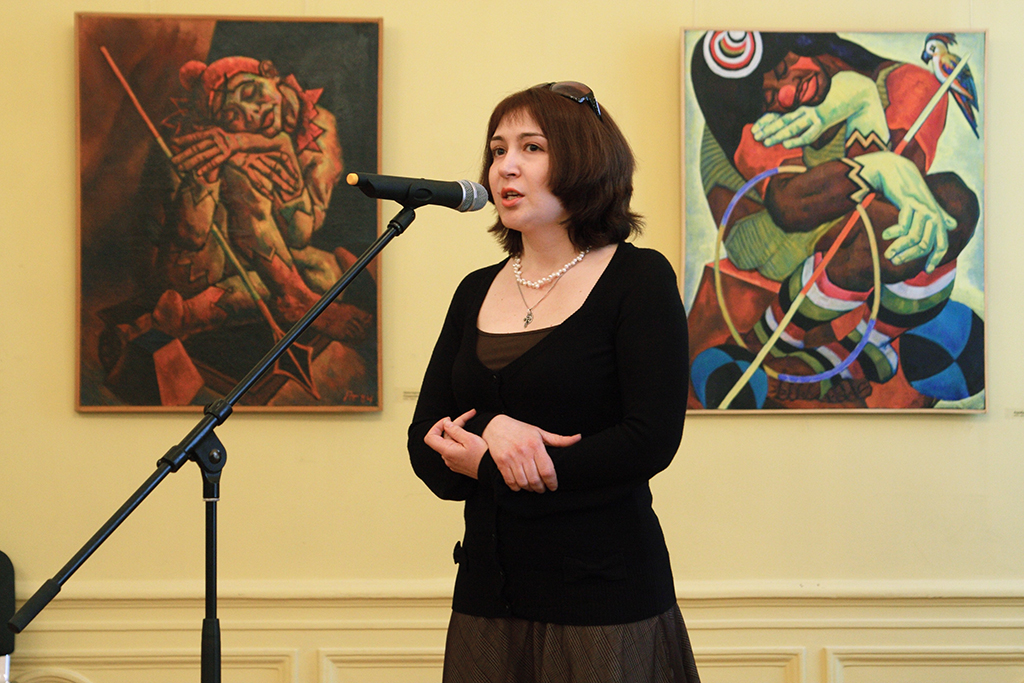
Quote from the speech by biographer and explorer of A.D. Tikhomirov’s art Gogoleva Ekaterina Nikolaevna:
“… His life was built on contrasts. Author of monumental portraits of Lenin and the party’s leaders, treating with official orders with irony, but performing them on high professional level, he saw the meaning of his life and work in creation of art of completely different nature. Income earned for Lenin’s portraits allowed him creating real art works and ensure well-being of his family, whom he loved dearly.
His portraits of Lenin were seem by thousands, hundreds of thousands of Soviet people during the public holidays, and the paintings which were dear to his heart were only known to art experts, completists and the artists during the Soviet times, and first exhibition of his works only took place in perestroika times, in 1987. Then there have been other exhibitions, both group and persona, and today there is a retrospective exhibition devoted to the 95th anniversary from the date of birth of the artist.
Contrasts… Having damaged his eye crystal so that only one eye remained sighted, being devoted to his work Tikhomirov did not abandon painting. Moreover, he was putting titanic workload on himself, laboring at the workshop all day long, and during his last years, already being severely ill, he would still spend not less than 6 hours a day behind easel.
Appearing to be reserved and calm person, he possessed hot temper and passionately loved his wife Natalya Anatolyevna Vinogradova. He devoted to her a cycle of wonderful fauvist works “Petroushka and the Ballet Dancer”, inspired by I. Stravinsky ballet “Petroushka”. Alexander Dmitrievich was fond of cinema, theatre, and his neoclassic works devoted to theatre and circus are created under impression from the movies by Fellini, Antonioni and Bergman, as well as Shakespeare’s dramas and sonnets, so much admired by him. Like the famous play-writer, he created entire gallery of expressive and memorable images in his paintings. He passed away, having left us a unique creative heritage”.
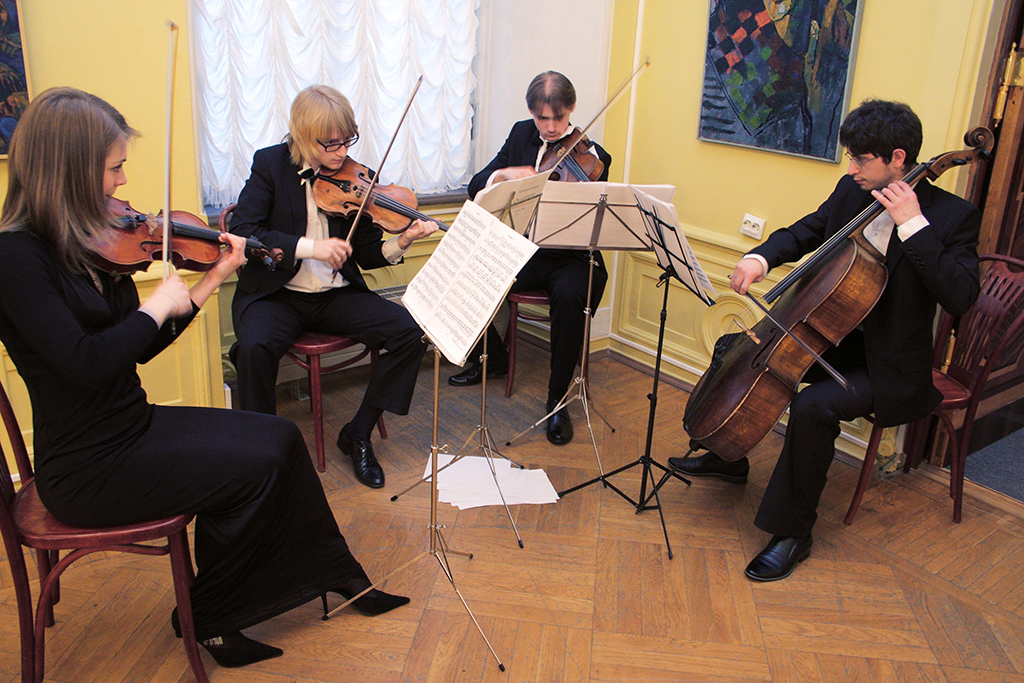
During the entire evening halls of the Marble Palace were filled with music. Musicians of “Borealis-quartette” (Saint-Petersburg) Rimma Kozlova (first violin), Andrey Prokazin (second violin), Boris Botvin (viola) and Igor Botvin (cello) played music of the artist’s favorite composers, including Mozart and Tchaikovsky.
Ekaterina Gogoleva
ACKNOWLEDGEMENTS
Heirs of the artist would like to express their gratitude for support in organization and preparation of the exhibition to:
The leadership of the State Russian Museum – Deputy Derector in charge of scientific work E.N. Petrova
Exhibition supervisors I.F. Uritskaya (Moscow) and L.V. Shakirova (Saint-Petersburg, Russian Museum)
Heirs of the artist would like to express special gratitude to V.A. Matveev and E.N. Gogoleva, as well as the musicians of “Borealis-quartette”.
See publications and video materials devoted to the exhibition in the Russian in “Mass media” section.

